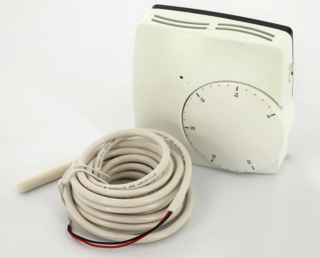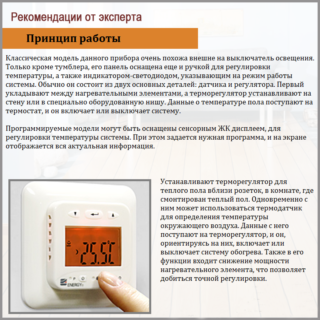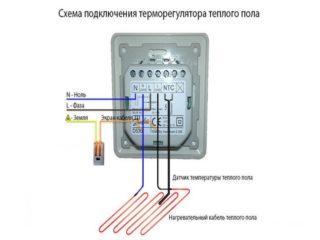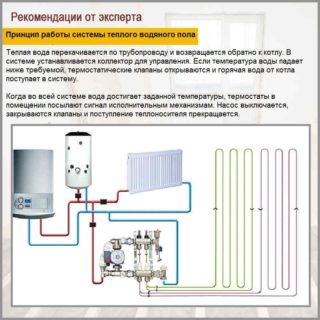One of the types of space heating is the "Warm floor" system, which allows the owner to save the necessary microclimate in the rooms. At the same time, he can set the required temperature with his own hand. Each of these systems is equipped with a special device through which such an adjustment is carried out - a warm floor sensor.
- Principle of operation
- Features and benefits of use
- Types of temperature sensors for underfloor heating
- Thermostat functions and selection
- Pros and cons
- The choice of a warm floor sensor depending on the floor covering
- Installation of thermostat and sensor
- Replacing the temperature sensor
- Application and operation
- Precautions
- What to do if the sensor is not installed
Principle of operation

The correct functioning of the thermostat is guaranteed by a thermostat and a temperature sensor. The principle of operation is to fix the floor surface or the air in the room with a temperature sensor, after which the electricity supply is blocked by a thermostat. After the temperature has dropped to the set value, the system is switched on again for heating. Thanks to such cycles, energy is saved, and the temperature set in the room is constantly maintained.
Features and benefits of use
The floor heating system, in addition to the thermostat itself, includes a specialized floor sensor, or rather temperature. The installation of the second device is carried out using a plastic corrugation. This device is placed directly in the floor screed.
The latest generation thermostats are programmable, which is extremely beneficial and convenient. For example, the owner of the room can configure the device in such a way that, in its absence, the heated floor will work in an energy-saving mode, and for the time set before the owner arrives, the system will automatically switch to full heating, providing a comfortable temperature in the house.
The cost of programmable regulators is higher than devices without such a function. However, due to the economy in energy consumption, the difference in cost will be compensated for in a maximum of 3 heating seasons.
Types of temperature sensors for underfloor heating
There are several types of thermal sensors, here are the main ones:
- With energy saving mode - they allow you to lower the temperature in the room by a set number of degrees for a certain period when the owners of the house are absent.
- With programming timer - temperature control is performed using a preset timer. It sends signals to the temperature controller, adjusting the heating power at a specific time.
- Intelligently programmable - the display of the device allows you to set the alternation of the set heating modes.
- With limit sensor - allows you to set the minimum and maximum heating power at a set ambient temperature.
Each of the above sensors helps to protect against potential overheating, which can harm the integrity of the floor screed.
Thermostat functions and selection
- Technical parameters: mechanical, electronic or electronic programmable. The water sensor can be built-in or remote.
- Device power - it is better to choose a thermostat with a slightly higher power than is required for the system so that it does not experience maximum load.
- Mounting method - surface-mounted, built-in or for connection from a DIN rail.
- Stylistics - the regulator can be of different colors and shapes (square, circle).
- Number of channels: single channel or dual zone.
- Control type - can be mechanical, electronic or touch.
The most common are built-in single-channel thermostats. They will be the ideal option for apartments.
Pros and cons
Thermostats for floor heating are a necessary and irreplaceable thing. Their relevance is explained by a whole set of advantages:
- loyal value;
- ease of management;
- efficiency in electricity consumption;
- easy installation;
- high level of ergonomics;
- turning on / off the heating system in automatic mode;
- reliability and durability;
- the ability to make settings in the device memory.
The thermostat has practically no minuses. Its main disadvantage is the complexity of primary programming. But this is not so critical, because the temperature settings are entered into the device once.
The choice of a warm floor sensor depending on the floor covering
A separate type of sensor is installed under each type of floor covering.
The device is of the following types:
- Mounted under soft types of flooring: carpet, linoleum. The sensor in this installation is represented by a small cylinder, which is attached to the end of the cable segment. It is installed only after the concrete screed is completely dry. A narrow groove is made in the finished screed for the sensor.
- Mounted under a hard-type coating - the sensor here is larger, covered with a gel shell that protects the device from mechanical damage.
Gel-coated sensors are the most reliable because they withstand high loads. They are ideal for installation under laminate and parquet floors.
Installation of thermostat and sensor
If the heated area is large, the electric underfloor heating is mounted in separate blocks, each of which has its own control system.
Before installing and connecting the thermostat, it is imperative to de-energize the room.
Installation diagram:
- A hole is made in the wall for a mounting box, into which the thermostat will be installed. Below is a strobe for laying the wiring. The box is mounted on a regular place.
- The wiring is being laid. Power cables and temperature sensor wires are connected to the back box.
- The temperature controller is mounted in the box and securely fixed, it is connected to the wiring.
- The main nodes of the system must be connected in accordance with the instructions attached to the device.
- Finally, the front panel is installed and fixed with screws. It must be installed by level.
You can install a thermostat with a sensor yourself. The main thing is to strictly adhere to the attached instructions.
Replacing the temperature sensor
The cause of the temperature sensor malfunction can be checked with a tester. He discovers two reasons, both associated with problems in contacts - he either is or he is not, where he should be.
First, an input wiring test is performed. You need to connect the power and check for voltage in the wiring. If no problem is found, the test is performed on the output wiring. The thermal circuit is disconnected from the regulator when the power is on. If there is no voltage on the wiring, this means that the temperature sensor is out of order.The old sensor for underfloor heating is dismantled, and a new one is installed in its place.
Application and operation
- the device must be mounted on internal walls;
- installation height should not exceed 1 m;
- the thermostat should not be exposed to direct sunlight;
- do not install the device near the door;
- the thermostat must not be covered with curtains or curtains.
Subject to the rules of operation, the warm floor will serve the owner for at least 10 years. Unskilled actions during installation and further operation can reduce this period by half.
Precautions
The main security measures are as follows:
- Before connecting the device, it is necessary to de-energize the room.
- The disassembled device must not be connected to the mains.
- The regulator cannot be used if the ambient temperature exceeds +40 degrees.
- The thermostat must be regularly cleaned from dust.
- It is strictly forbidden to wash the device with solvents.
For a person who is far from an electrician, it is better not to carry out the installation or repair of the thermostat on his own. So you can de-energize the entire high-rise building, but also harm your own health.
What to do if the sensor is not installed
It is possible to use a warm floor in the absence of a temperature sensor, but it is extremely risky - the floor covering may collapse. The problem is solved by several methods. The system can be equipped with an air sensor, but it is only suitable for cable type systems. In this case, the power of the heating circuit should not exceed 170 W / m2.











